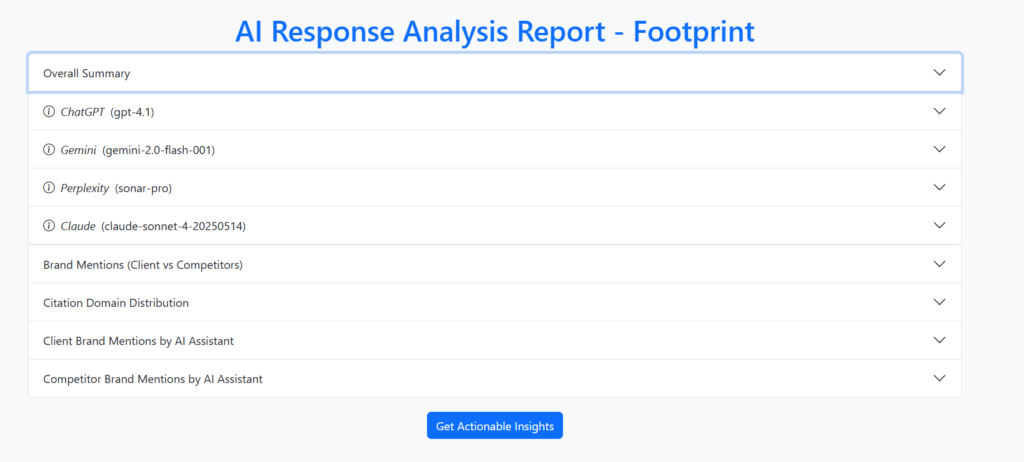
It’s a question more businesses are starting to ask as generative AI changes the way people discover information online.
While Google still dominates traditional search, tools like ChatGPT, Claude, Perplexity, and Gemini are rapidly becoming the go-to for summarised, conversational answers. The way these tools reference brands and share information is completely different from the classic list of blue links.
That shift is beginning to redefine what visibility means.
At Footprint Digital, we’re always exploring new technologies that help our clients stay ahead. So when our Technical Director, Chris Ainsworth, built an internal tool to monitor brand mentions across AI search engines, we knew we were onto something exciting.
The tool allows us to track whether and how brands are being mentioned in generative responses from AI tools.
It’s part of a broader mission to better understand how AI influences the customer journey and where opportunities lie to influence it.
The Traditional Model of SEO is Evolving
For years, marketing success has meant ranking at the top of search engine results pages.
But as AI assistants increasingly summarise and synthesise information, ranking is no longer the whole picture.
Now the questions are: is your brand included in that summary? Is it trusted enough to be cited? Is it visible in the emerging AI layer of search?
With the rise of zero-click searches and Google’s AI Overviews, users are getting answers without ever clicking through to a website. This shift means visibility in AI-generated content is now just as important, if not more, than traditional SEO rankings.
This is where our AI visibility tool comes in.
It allows us to monitor brand mentions in responses generated by AI assistants, offering insights into which brands are being favoured, how often, and in what context.
It also helps us understand which sources are being cited by these tools, revealing patterns in the types of content and publishers that influence AI-generated answers.

Constantly Changing Results from Generative Search
One of the most powerful things this tool uncovers is how wildly results can vary between different AI platforms and even on the same platform.
Ask ChatGPT a question about the best UK home insurance providers, and you might see one set of brand mentions.
Ask Claude, and you’ll get a completely different answer, or sometimes no brand recommendations at all.
These behavioural quirks matter. They shape how users perceive authority and trust, and they affect how marketers tailor strategies for each platform.
The inconsistency between tools makes it clear just how complex the AI landscape has become.
For marketers, this means that simply optimising for one platform isn’t enough.
Visibility now demands a broader, more nuanced approach. It requires understanding how different models think, behave, and choose what to include in their responses.
Research and Development in AI Optimisation
Chris is quick to emphasise that this is not a polished reporting tool. It’s a research and development project. It’s helping us learn, test, and explore the shifting world of AI search in real time.
That means running experiments, tracking changes over time, and building up a picture of what success looks like for different clients in this new world of visibility.
We’re already seeing value from these insights.
One use case is competitor benchmarking. If your brand is never mentioned in AI answers but your competitors are, that’s a signal worth paying attention to.
Another is content strategy. By identifying which sources and types of content are being cited by AI assistants, we can begin to refine our digital PR efforts and on-site content strategies.
This moves us toward the kind of content that is not only discoverable by people but also learnable by machines.
Citation Patterns for Digital PR
We’re also starting to see patterns in the types of sites that AI tools prefer to cite.
It’s not always who you’d expect.
While household-name publishers appear frequently, niche blogs, specialist forums, and product review sites also often surface in citation data.
This has real implications for content strategy and digital PR. It suggests that earning citations in the right places, not just the most obvious ones, could increase your chances of being represented accurately in AI responses.
The Shifting Search Landscape
Ultimately, our work in this space is about helping clients to stay ahead of change.
The search landscape is shifting rapidly, and we believe marketers need to shift with it. That means not just reacting to where things are today, but investing in learning, experimentation, and innovation to prepare for where they’re going next.
We don’t have all the answers yet, but we’re building the tools and expertise to help our clients be ready for whatever’s coming.
Future Proofing Your Brand
This is about more than visibility.
It’s about future-proofing your brand in a world where information is filtered, summarised, and delivered by machines.
The question is no longer just “Can people find you on Google?” It’s becoming “Can AI find you, trust you, and talk about you the way you want to be represented?”
If that’s a question your business is starting to ask, we’d love to help you explore the answer. Get in touch if you would like to see how your brand is performing!




